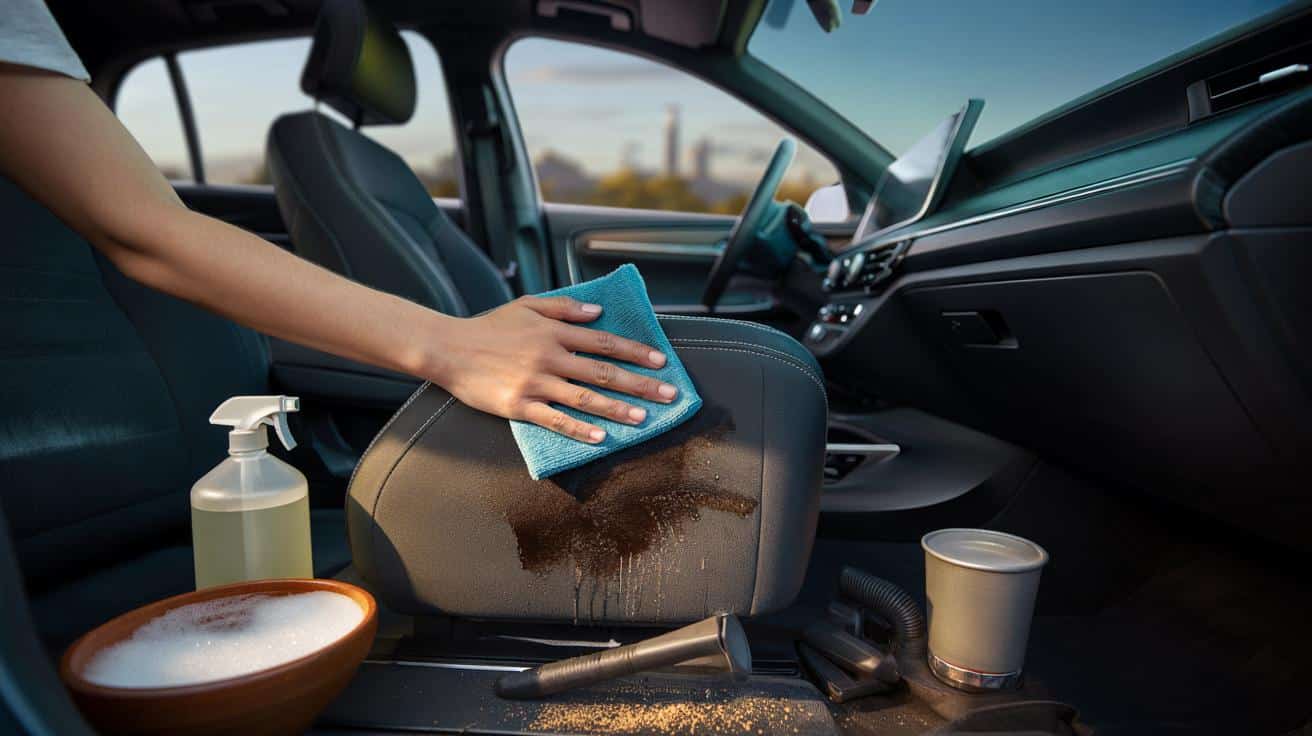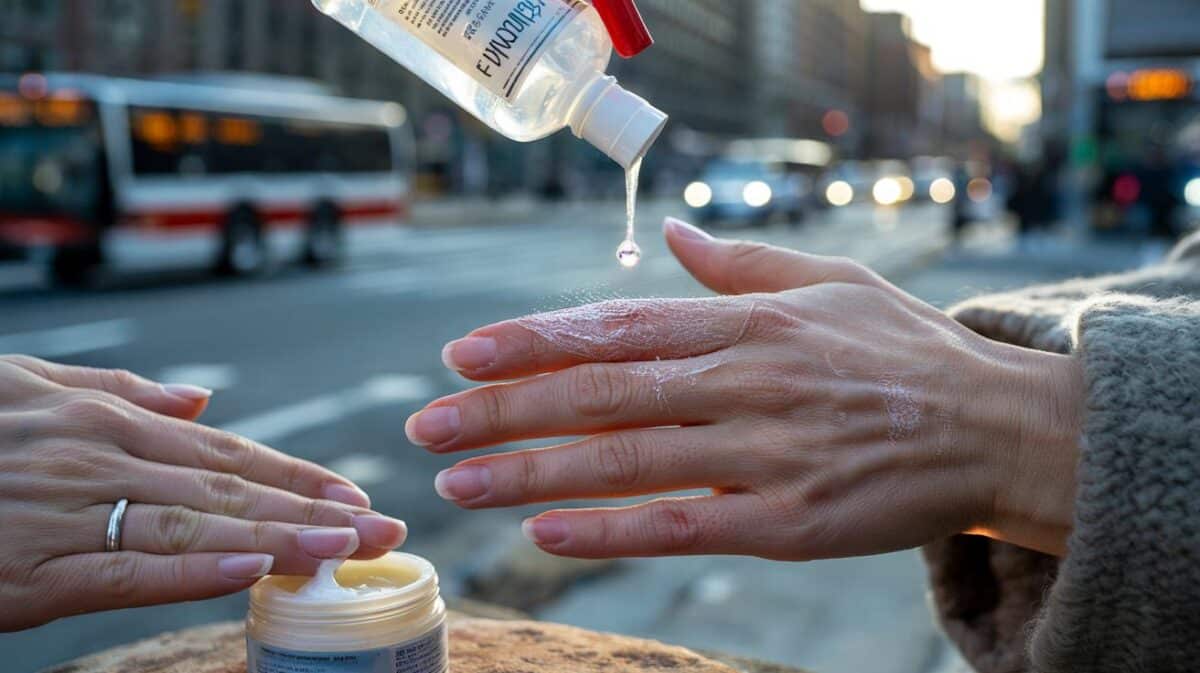Odours linger. Colours dull. Morale drops.
The cold months pile on moisture and muck, yet most stains surrender with a calm hand and a cheap, quick routine. You do not need a wet vac or industrial chemicals. You need a measured mix, a light touch and patience with drying time.
The £1 home mix that lifts stains without rings
Keep it simple and precise. This method targets everyday grime, fresh food marks, coffee drips and greasy handprints. It also avoids tide marks, which often appear when water spreads dirt to clean fabric.
Mix 500 ml warm water, 50 ml white vinegar and 1 level tablespoon mild washing-up liquid. Blot, do not rub.
- Decant the solution into a bowl or trigger bottle.
- Vacuum the seat thoroughly, including seams and stitching.
- Lightly dampen a clean microfibre cloth with the mix. Do not soak it.
- Press on the stain with short, repeated blots. Work from the outside in.
- Flip to a clean section of cloth as dirt lifts.
- Rinse the area with a second cloth dampened in clean water.
- Dry with cold air. Open windows. Aim a fan at the seat. Avoid heat on leather trims or heated seats.
Patch test first on a hidden area. Check for colour transfer after 60 seconds. Stop if dye lifts.
Why this £1 mix works
Warm water softens dried residues. Washing-up liquid lowers surface tension and lifts oils from fibres. The mild surfactants suspend soil so the cloth can pick it up. White vinegar contains acetic acid, which breaks down alkaline stains, salt traces and some odours. The low cost comes from small quantities and cupboard staples.
Alternatives when water is risky or the stain is stubborn
Some marks respond better to dry methods, especially on delicate fabrics or when you cannot wet the foam beneath the seat cover.
Bicarbonate of soda for odours and light marks
Sprinkle a fine layer over the area. Tap gently so it touches the fibres. Leave for 60 minutes. Vacuum slowly with a brush attachment. It absorbs moisture and neutralises smells. Repeat overnight for spills such as milk or soft drinks.
Talc or fuller’s earth for grease
Cover fresh grease with talc or fuller’s earth. Do not press in. Leave for two to three hours. Brush off and vacuum. If a halo remains, use one round of the £1 mix and blot again.
White shaving foam for colour-rich stains
Use plain, unscented, white foam only. Spread a thin layer with your fingertips. Wait five minutes. Blot with a damp cloth. Rinse lightly. Dry fast. This can brighten dull patches and lift old grime from tight weaves.
The method at a glance
| Stain type | Best first step | Dwell time | Water needed |
|---|---|---|---|
| Mud, soft drink, coffee | £1 mix, blot from edges inward | Immediate | Low |
| Grease, sunscreen, lipstick | Talc or fuller’s earth, then £1 mix | 2–3 hours for powder | Very low |
| Milk, sick, pet accidents | £1 mix, then bicarbonate overnight | Overnight deodorising | Low |
| Crayon, marker, dye transfer | White shaving foam, then rinse | 5 minutes | Low |
Common mistakes that leave rings, smells and damage
- Soaking the seat. Water sinks into foam and traps musty odours.
- Scrubbing. Friction roughens fibres, spreads dye and sets stains.
- Heat drying. Warm air bakes in marks and warps foam.
- Skipping vacuuming. Grit turns into abrasive paste when wet.
- Using coloured or perfumed foams. Dyes and fragrance oils can stain.
Keep moisture on the cloth, not in the seat. Use many light passes rather than one heavy wetting.
Care tips that save time through winter
Clean fast, dry faster
Treat fresh spills within minutes. Fresh sugar stains lift in seconds. Dried ones can take three passes. Speed up drying with a fan, dehumidifier or open doors on a breezy day. Winter air often sits dry, which helps.
Vacuum weekly
Crumbs and grit cut fibres. A five-minute vacuum stops polishing by friction. Pay attention to piping, creases and ISOFIX anchors where dirt hides.
Trap moisture and odours
Slip a breathable sachet of bicarbonate or silica gel under each front seat. Replace monthly. Avoid scented beads in cars with allergies.
Protect high-risk zones
Child seats and booster areas collect spills. Use a thin, washable protector under seats, approved for use with your restraint system. Check your vehicle manual before fitting covers near seat-mounted airbags or heated elements.
Safety, materials and when to escalate
Many modern cars use synthetic weaves or faux suede. These react well to the £1 mix. Alcantara and other microfibre suedes demand a lighter touch. Keep water cool, use minimal moisture and brush pile gently as it dries. Always test for colourfastness on a hidden edge.
Pungent biological stains may need enzymes. Mix one teaspoon of biological laundry powder in 300 ml warm water. Blot, wait five minutes, then rinse. Do not use enzymes on wool blends. Never mix vinegar with bleach or products containing chlorine.
If the smell lingers after two or three cycles, the foam may hold residue. Rent a small upholstery extractor for a single deep pass with clean water. Extract thoroughly, then dry with strong airflow. Avoid repeated soaking.
What this costs and how long to allow
The £1 mix uses around 50 ml vinegar (about 5p), a tablespoon of washing-up liquid (about 3p) and half a litre of tap water. The big cost is time and cloths. Plan 10 minutes per stain, 30 minutes to dry with airflow and a second visit if a shadow returns.
Most family cars reclaim their look in under an hour. Heavier jobs may run to two hours with drying. Work one seat at a time. You can drive while it dries if the fabric is only damp to the touch and seat heaters remain off.
Extra gains you can make today
Finish with a fabric protector that is free from long-chain fluorocarbons. Two light coats after full drying will slow future stains and make quick blotting more effective. Reapply after deep cleans or every three months in winter.
Track recurring stains. If you keep seeing greasy spots near door pulls, add a small pack of interior wipes in the door bin. If sports kit brings in odours, line the boot with a washable mat. Small changes cut cleaning in half and keep that just-cleaned look longer.








